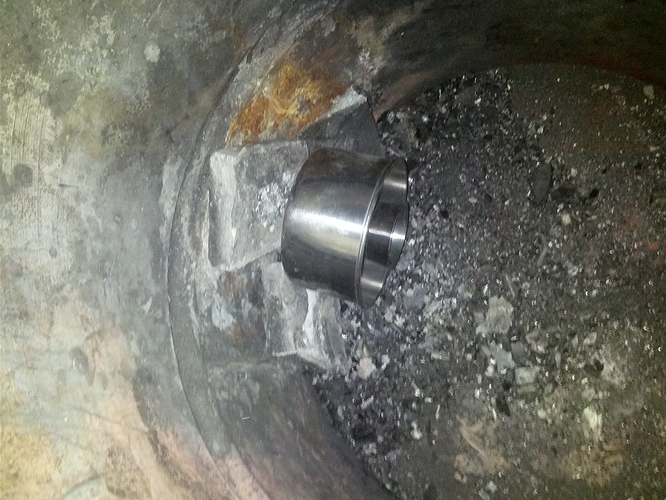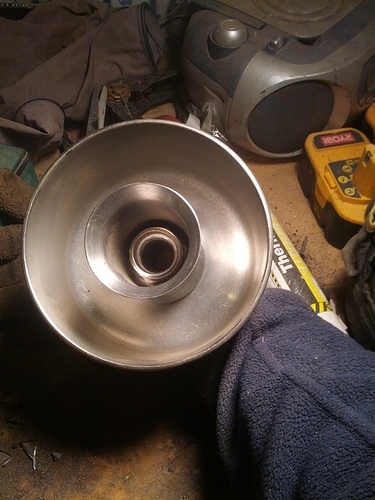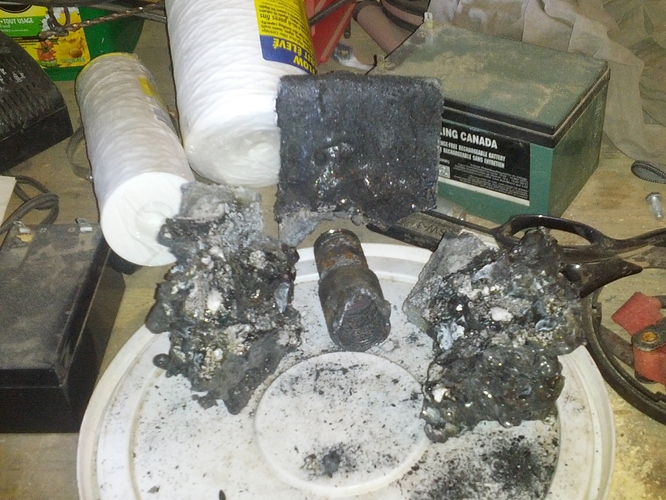Don I think erosion of the nozzle is best corrected with material — stainless or ceramic. TomC
What I meant was the whole idea of the bell is to keep charcoal from touching the nozzle and thus eating it away. Won’t it eat away anyway with the heat or does charcoal have to touch it first?
Sorry. Ok I see what you are saying. My “guess”; a match makes heat waves, you can put your finger beside the flame and not get burned, Put your finger IN the flame and you get burned. After shoveling hot char into a 55 gal drum I concluded that charcoal puts out “radiant” heat. So I think the heat will radiate back to the nozzle. The only way to save the nozzle would be to control the distance from the tip to the charcoal. Further is better for the life of the nozzle.TomC
What is the insulation value of charcoal?
Steel in a carbon monoxide environment at high temperature starts to absorb carbon.
This surface hardness will cause common steel to become very brittle and crack/spall in heating and cooling cycles.
Its also how case hardening is done intentionally in some applications
Are the tueyers crumbling or burning off??
I don’t know Don is it the coals or oxidation ? I would like to play with it but made no charcoal for a long time. Thinking I should I wanna play with some dc power generation for Steve’s challenge.
I wonder if this bell might work? Run a three inch pipe down from the top of the charcoal container. Inside this pipe would be the air inlet pipe tipped with a ceramic TIG nozzle. Three bolts through the large pipe would keep the inner pipe centered, and determine how far the nozzle protrudes.
http://www.ebay.com/itm/-/222036683108?
Outgoing gas would preheat incoming air. At the top would be a 3" Tee. Outgoing gas taken off horizontally, incoming gas feeding through a 3" pipe cap into the smaller tube. (Note, I am the seller of this reducing bell.) The bell would need to be near (maybe 12" or 30 CM) the bottom of the charcoal container which would have a replaceable firebrick at the bottom. Build an airtight access hatch on the side for inspection of the nozzle and removal of the clinkers/slag. Add a hatch at the top for fresh charcoal. Flaring: Expect lots of dust in the flare, which will probably be a Gold/Yellow color. Check the Kalle gasifier wind sieve design. Torsten Källe’s charcoal gasifier
The Making of the Kalle Gasifier | Gasifiers Also on page 24 of this document: http://www6.zetatalk.com/docs/Gasifiers/German_Ideas_On_Improvements_Of_Wood_Gasifiers_1941.pdf
I mentioned earlier that Martin and I had flared our “Kalle” for hours and hours because of the Gold/Yellow flame. It was suggested that the charcoal may have contained sodium from my red clay soil, or perhaps I had thrown too many armadillos into the charcoal making barrel. My current belief is that it was the charcoal dust that colored the flare.
How far should the nozzle protrude beyond the bell? What is the angle of repose for the feedstock you are using? I’d draw it full or half scale and locate my nozzle tip where the angles intersect. Just my 2 cents…
Arvid, Building this according to Chris’s drawing, I would put the end of the ceramic Tig cup right where the bell changes from 3" to 4" for maximum protection from the glowing char underneath, depending on air velocity to reach downwards. The second drawing in the first post, accredited to Max, would put the nozzle just below the end of the bell, and this is where one could draw in charcoal showing angle of repose. The inner fresh air pipe can be adjusted up and down if bolts are used to center it inside the output gas pipe. This would need a good gob of RTV at the top pipe cap where the inlet tube enters, so it could be moved up and down to raise or lower the nozzle. We didn’t do that because we built provisions for feeding/augering in wood chunks as Gary showed in his video. (More H, CO, and CH4) We actually welded an extension on the end of our black iron pipe nozzle to make it longer (and to replace the burned away portions). Remember, our output gas was taken out higher up, after passing through charcoal and then a stainless screen into the space between the nozzle tube and the coaxial outer tube.
I have been thinking about this tuyere erosion question and decided too look at the material end of the problem.
The hottest things I have really looked at are the oxygen lances in inco flash and q-bop furnaces.
Burning the metal spalling problem seem to be controlled by using copper tuyeres and water cooling.
Would that work out in a charcoal gasifier well enough to off-set the downsides?
I mean, yes, one could provide enough water cooling to give the tuyere a bit longer lifespan, but I would think that it would also suck a lot of thermal energy out of the core.
That thermal energy could be used to reduce CO2 and H2O vapor (e.g. exhaust recycling) which will temper the core enough to save the tuyere (mostly) and increase the energy content of the produced gases.
In my mind, the main advantage of charcoal vs wood is the simplicity of the gasifier. If we now need to add water cooling and all that, it’s no longer a simple unit.
I have looked at this problem and found some examples in the past that used a water cooled tuyere.
This was a problem then and its still a problem now but it would appear that cooling water was used to make steam.
The amount of cooling required and the amount of steam produced seems to have been proportional so its not a drain on the system thermal balance.
Seems to be two ways they controlled the flow of water.
One used a float to hold a certain amount in the tuyere base.
The other seems to have been piped to a tank and used convection ( not sure how much steam would be produced that way and it probably was very slow to change steam production.
The trouble is the old documents do not tell us too much about materials and there are not a great deal of pictures.
Would copper really work here?
All I know is an oxygen lance has to last in a furnace and the conditions in there are absolutely hellish compared to the balmy weather in a gasifier.
Looking at the first sketch, getting my 2 cents together…
The only gas coming out of this bell is going to be hot Co2…
Since there is no gas passing layers of glowing charcoal, no dwell time to converse one matter in another.
The air will just heat up and burn the charcoal away coz there is no charcoal barrier to pass between the air sucked out the bell and the nozzle point.
It would be different if the gas outlet is on the other side of the bell, then the gasses would have to pass the layer of charcoal
Copper tuyeres are currently being used by those who are smelting iron ore to make authentic iron age implements. The smelters run at 1200C. The requirements to prevent both melting and catastrophic oxidation of the copper are two: 1) the tuyere wall must be at least 1/4 inch thick to conduct enough heat away from the hot end, and 2) the copper must extend to the outside of the smelter to release the heat into the ambient air. I have used a 5/8 ID, 1 1/8 OD copper pipe as a tuyere in a charcoal gasifier. The gasifier was flared for over an hour without corroding the tuyere. There was only a light green patina on the final 2 inches when inspected. Since that experiment, I have read a research paper claiming that nickel plating copper for use in high temperature environments reduces catastrophic oxidation to 1/20th of that for unplated copper. My plan is to use a 1"ID, 1 1/2" OD, nickel plated tuyere in the charcoal gasifier on my MGB. I hope to bring this vehicle to Argos this year. I leave for two weeks in Rwanda tomorrow and will get back to work on this project when I return.
I have some experiances with copper water cooled touyeres. My oppinion on the subject is they wuld be great for a stationary system where it is alot easyer to operate and meter water but for a moveing gasifier its just noth worth the extra effort. Like said a bit higher on the thread the buty of charcoal gasifiers is its simplisity.
I just opened my gasifier the other day. I have a thick steel hydraulic cilinder with 4 holes to serve as nozzles and it just works great. The pipe is just as it was when l put it in eaven thugh i eaven with about an hour of full air flow and 0 coolant. I will post some pictures when l open again.
Whoops, get side tracked for a few days (maybe a week) and find all sort of interesting stuff here.
The design Chris put up as sketched will not work, The nozzle will oxidize the charcoal into CO2 that will get sucked up the outlet pipe. Koen and Brian have it pegged. The hot CO2 MUST be forced through a bed of charcoal to reduce it into CO. This design does not permit that. As David notes, if the gas was pulled from the area outside the cone and through cooler charcoal, then it could work. Basically this is the Kallhe design. The shield may work in this situation. My poor Ford Ranger has been sitting for about two months now while I use my time for other projects. But I am thinking of taking the Kalle style gasifier on my Model TT truck and using it for the Ranger. It has a ceramic nozzle and putting a cone shield on it would be easy. Let me speculate that the cone will burn up as the heat is too intense. BUT, it may work. Definitely something to try.
With the Simple-Fire there is a horizontal nozzle. One of Max’s ideas was to use a tent like structure to keep the charcoal away from the nozzle. Basically it did not work because it burned up in the intense heat where the oxygen reacted with the charcoal.
Gary in PA
These were horizontal but the goal was the same
Preserve the nozzle with a shield. I did not have any luck with it; As shown in last picture. Who knows what went wrong, not enough exhaust injection bad stainless… bad design. I retired this one too hard to get a good seal. Best luck I have had is with the 45 degree tractor nozzle and cast refractive.
Yeah, David, that is what I would expect too. Even with exhaust gas added you can prolong the life of the nozzle but other shields seem to get cooked!
Gary in PA
How many hours on that failure?
I mowed my grass for a whole summer before I looked at mine. The stainless shield was gone and the pipe was just a stub. I an sure I had 20 plus hours on it, I was still working as good as ever. As far as I am concerned that’s good enough for me. The simple fire was never said to be the best but the easiest.


